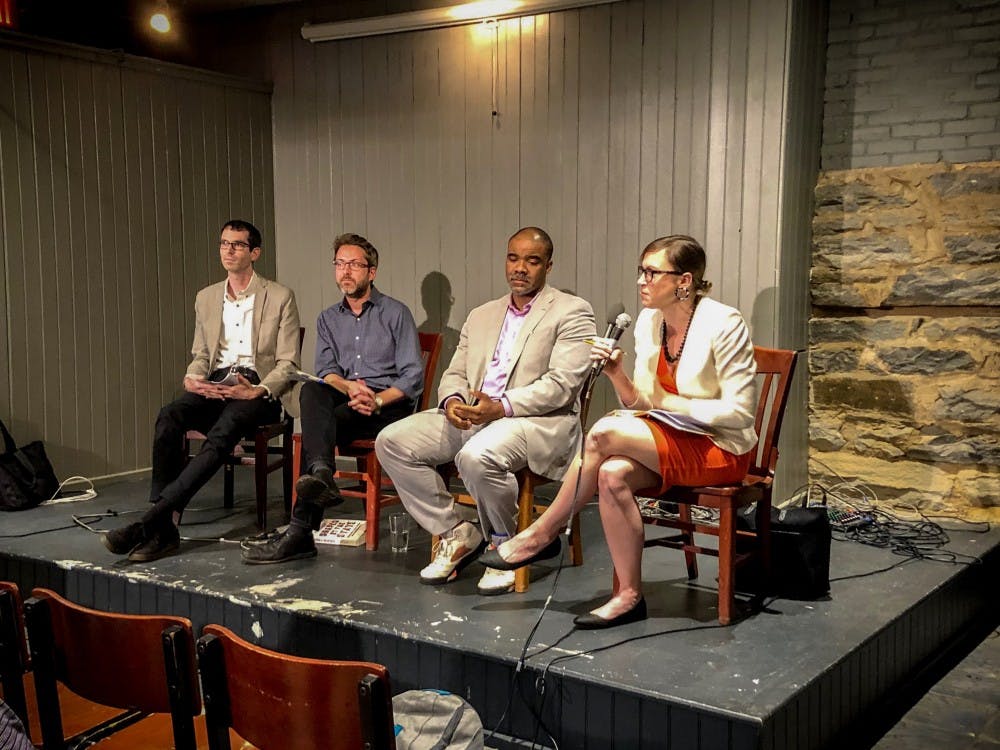Co-authors, University of Pennsylvania history professor Brent Cebul, Hopkins associate professor of history Nathan Connolly, and Hopkins sociology professor Stuart Schrader, gave a talk about their book Shaped by the State at Red Emma’s Bookstore on Thursday April 18. Christy Thornton, Hopkins assistant professor of sociology, moderated the discussion, which centered on race and the prison system in relation to the two-party system in America.
Cebul described the scope of the modern study of political history as having grown increasingly limited in recent years, focusing more on politics and less on the context that shapes it.
“Political history, as political historians were writing it, had become really narrow. Its imagination was really limited in regards to what counts as political and not,” Cebul said. “The Trump phenomenon really drove that point home that political historians were caught on their back feet in trying to explain how this could happen.”
Cebul compared the recent shift in perspective, after Trump’s surprise victory, to the shift that occurred decades ago, when many political historians who approached their analysis through the New Deal lens found themselves lost after Reagan’s election.
“The New Deal order, as a concept, was one of the most powerful frameworks of understanding the political course in 21st century,“ Cebul said. “When Reagan got elected in the 1980s, there was this urgency among the new left to literally conduct an autopsy about what had happened to a perceived period of progress. And so, the main actors that were studying about the late rise of mainstream conservativism were mainly thinking about the white working class.”
Cebul added that when pushback against the focus on the white working class began to occur in the 1980s, most of those arguing for this new perspectives did not consider themselves part of the political science establishment.
“What started to happen professionally was that a lot of folks were writing really rich political histories about African Americans and the experience of citizenship,” said Cebul. “Some of the best political literature about... citizenship and identity were happening not by people who considered themselves political historians. We’re learning things like, the experiences of citizenship as felt by African Americans weren’t that different under Roosevelt than from under Reagan. And the New Deal order framework of history didn’t have a whole lot to say about that.”
Connolly argued that what mainstream political analyses fail to capture is the experiences of black Americans throughout the rise and fall of liberalism.
“The strange part about American liberalism is this strange tension where people are believing in process, reform and persuasion, but the underside of this is that white power is setting the rules,” Connolly said. “What we’ve forgotten about segregation and liberalism is that Jim Crow was regulation...the web of laws that set the terms for how the contract relationship under liberalism was exercised. This is very much built into today’s party politics with the sense that if you get access into either party circles, you will find your white benefactor.”
Schrader spoke on the prison system or the carceral state, and its tools of policing and punishment to regulate interpersonal relationships and their transgressions. According to Schrader, the carceral state is not just limited by domestic boundaries, but is also shaped by U.S. foreign policy.
“We need to put the carceral state at the center of U.S. political history,” Schrader said. “Once that is placed in the center, it changes how we think about politics. One way, of course, is that incarceration changes what the electorate, voters and our districts looks like.”
Looking more broadly, however, Schrader proposed looking at incarceration and punishment as a result of bipartisan thinking.
“The very model of bipartisanship is drawn, in turn, from national security. We can then make connections as to how the carceral state has functioned as a depoliticizing tool during the Cold War,“ Schrader said. “This bipartisan commitment to fighting the Cold War has been translated into the language of fighting a war on crime.”
Junior Riya Rana, one of Thornton’s students, attended the event because she was curious about race relations in the U.S.
“People are having such rigorous debates on Twitter like what it means to be a Democrat or Republican,” said Riya. “The event encouraged me to contextualize the upcoming election in a history of continuity. It was interesting to think about stepping out of our current partisan categories and realize that contemporary politics are shaped by politics way back in the 70s, 80s and 90s as well.”





